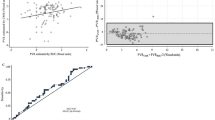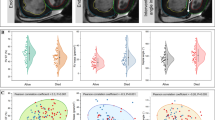Abstract
Remote dielectric sensing (ReDS) system non-invasively quantifies pulmonary congestion. Re-admission following trans-catheter aortic valve replacement (TAVR) remains an unsolved matter. Residual pulmonary congestion is a strong risk factor of worse clinical outcomes in patients with heart failure. ReDS system may have a prognostic impact in patients undergoing TAVR. Patients who received TAVR and ReDS measurements during index hospitalization between 2021 and 2022 were included. The prognostic impact of ReDS value on the composite endpoint of death or re-admission following index discharge was investigated. Totally, 42 patients (median 84 years, 14 men) were included. Median ReDS value at index discharge was 27% (24%, 30%) and 10 patients had ReDS values > 30%. During a median of 316 (282, 354) days following index discharge, a higher ReDS value at baseline was independently associated with the incidence of composite endpoint with an adjusted hazard ratio of 1.32 (95% confidence interval between 1.10 and 1.58) with a calculated cutoff of 30%, which significantly stratified the cumulative incidence of the composite endpoint (78% in the high ReDS group [N = 10] and 36% in the normal ReDS group [N = 32], p = 0.002). ReDS technology may be a promising tool to predict future clinical outcomes following TAVR by quantifying residual pulmonary congestion. The clinical implication of ReDS-guided aggressive intervention following TAVR remains the next concern.




Similar content being viewed by others
References
Carroll JD, Mack MJ, Vemulapalli S, Herrmann HC, Gleason TG, Hanzel G, Deeb GM, Thourani VH, Cohen DJ, Desai N, Kirtane AJ, Fitzgerald S, Michaels J, Krohn C, Masoudi FA, Brindis RG, Bavaria JE (2020) STS-ACC TVT registry of transcatheter aortic valve replacement. J Am Coll Cardiol 76(21):2492–2516
Mack MJ, Leon MB, Thourani VH, Makkar R, Kodali SK, Russo M, Kapadia SR, Malaisrie SC, Cohen DJ, Pibarot P, Leipsic J, Hahn RT, Blanke P, Williams MR, McCabe JM, Brown DL, Babaliaros V, Goldman S, Szeto WY, Genereux P, Pershad A, Pocock SJ, Alu MC, Webb JG, Smith CR, Investigators P (2019) Transcatheter aortic-valve replacement with a balloon-expandable valve in low-risk patients. N Engl J Med 380(18):1695–1705
Kolte D, Kennedy K, Wasfy JH, Jena AB, Elmariah S (2021) Hospital variation in 30-day readmissions following transcatheter aortic valve replacement. J Am Heart Assoc 10(10):e021350
Imamura T, Narang N, Sobajima M, Tanaka S, Ushijima R, Fukuda N, Ueno H, Kinugawa K (2021) Inadequate cardiac unloading following transcatheter aortic valve replacement. Circ Rep 3(10):615–619
Zahid S, Din MTU, Khan MZ, Rai D, Ullah W, Sanchez-Nadales A, Elkhapery A, Khan MU, Goldsweig AM, Singla A, Fonarrow G, Balla S (2022) Trends, predictors, and outcomes of 30-day readmission with heart failure after transcatheter aortic valve replacement: insights from the US nationwide readmission database. J Am Heart Assoc 11(16):e024890
Ambrosy AP, Pang PS, Khan S, Konstam MA, Fonarow GC, Traver B, Maggioni AP, Cook T, Swedberg K, Burnett JC Jr, Grinfeld L, Udelson JE, Zannad F, Gheorghiade M, Investigators ET (2013) Clinical course and predictive value of congestion during hospitalization in patients admitted for worsening signs and symptoms of heart failure with reduced ejection fraction: findings from the EVEREST trial. Eur Heart J 34(11):835–843
Hausdorff JM, Forman DE, Ladin Z, Goldberger AL, Rigney DR, Wei JY (1994) Increased walking variability in elderly persons with congestive heart failure. J Am Geriatr Soc 42(10):1056–1061
Matsue Y, Kamiya K, Saito H, Saito K, Ogasahara Y, Maekawa E, Konishi M, Kitai T, Iwata K, Jujo K, Wada H, Kasai T, Nagamatsu H, Ozawa T, Izawa K, Yamamoto S, Aizawa N, Yonezawa R, Oka K, Momomura SI, Kagiyama N (2020) Prevalence and prognostic impact of the coexistence of multiple frailty domains in elderly patients with heart failure: the FRAGILE-HF cohort study. Eur J Heart Fail 22(11):2112–2119
Narang N, Chung B, Nguyen A, Kalathiya RJ, Laffin LJ, Holzhauser L, Ebong IA, Besser SA, Imamura T, Smith BA, Kalantari S, Raikhelkar J, Sarswat N, Kim GH, Jeevanandam V, Burkhoff D, Sayer G, Uriel N (2020) Discordance between clinical assessment and invasive hemodynamics in patients with advanced heart failure. J Card Fail 26(2):128–135
Amir O, Rappaport D, Zafrir B, Abraham WT (2013) A novel approach to monitoring pulmonary congestion in heart failure: initial animal and clinical experiences using remote dielectric sensing technology. Congest Heart Fail 19(3):149–155
Imamura T, Narang N, Kinugawa K (2023) Clinical implications of remote dielectric sensing system to estimate lung fluid levels. J Cardiol 81(3):276–282
Amir O, Ben-Gal T, Weinstein JM, Schliamser J, Burkhoff D, Abbo A, Abraham WT (2017) Evaluation of remote dielectric sensing (ReDS) technology-guided therapy for decreasing heart failure re-hospitalizations. Int J Cardiol 240:279–284
Imamura T, Gonoi W, Hori M, Ueno Y, Narang N, Onoda H, Tanaka S, Nakamura M, Kataoka N, Ushijima R, Sobajima M, Fukuda N, Ueno H, Kinugawa K (2021) Validation of noninvasive remote dielectric sensing system to quantify lung fluid levels. J Clin Med 11(1):164
Amir O, Azzam ZS, Gaspar T, Faranesh-Abboud S, Andria N, Burkhoff D, Abbo A, Abraham WT (2016) Validation of remote dielectric sensing (ReDS) technology for quantification of lung fluid status: comparison to high resolution chest computed tomography in patients with and without acute heart failure. Int J Cardiol 221:841–846
Imamura T, Hori M, Ueno Y, Narang N, Onoda H, Tanaka S, Nakamura M, Kataoka N, Sobajima M, Fukuda N, Ueno H, Kinugawa K (2022) Association between lung fluid levels estimated by remote dielectric sensing values and invasive hemodynamic measurements. J Clin Med 11(5):1208
Uriel N, Sayer G, Imamura T, Rodgers D, Kim G, Raikhelkar J, Sarswat N, Kalantari S, Chung B, Nguyen A, Burkhoff D, Abbo A (2018) Relationship between noninvasive assessment of lung fluid volume and invasively measured cardiac hemodynamics. J Am Heart Assoc 7(22):e009175
Izumida T, Imamura T, Kinugawa K (2023) Remote dielectric sensing and lung ultrasound to assess pulmonary congestion. Heart Vessels 38(4):517–522
Izumida T, Imamura T, Hori M, Nakagaito M, Onoda H, Tanaka S, Ushijima R, Kinugawa K (2023) Correlation between remote dielectric sensing and chest X-ray to assess pulmonary congestion. J Clin Med 12(2):598
Auffret V, Bakhti A, Leurent G, Bedossa M, Tomasi J, Belhaj Soulami R, Verhoye JP, Donal E, Galli E, Loirat A, Sharobeem S, Sost G, Le Guellec M, Boulmier D, Le Breton H (2020) Determinants and impact of heart failure readmission following transcatheter aortic valve replacement. Circ Cardiovasc Interv 13(7):e008959
Imamura T, Narang N, Onoda H, Tanaka S, Ushijima R, Sobajima M, Fukuda N, Ueno H, Kinugawa K (2021) Implications of elevated fibrosis-4 index in patients receiving trans-catheter aortic valve replacement. J Clin Med 10(24):5778
Felker GM, Ellison DH, Mullens W, Cox ZL, Testani JM (2020) Diuretic therapy for patients with heart failure: JACC state-of-the-art review. J Am Coll Cardiol 75(10):1178–1195
Imamura T, Izumida T, Narang N, Kinugawa K (2023) Changes in lung fluid levels with variations in the respiratory cycle. Heart Vessels 38:749–752
Author information
Authors and Affiliations
Corresponding author
Ethics declarations
Conflict of interest
The authors declare that they have no conflict of interest.
Additional information
Publisher's Note
Springer Nature remains neutral with regard to jurisdictional claims in published maps and institutional affiliations.
Rights and permissions
Springer Nature or its licensor (e.g. a society or other partner) holds exclusive rights to this article under a publishing agreement with the author(s) or other rightsholder(s); author self-archiving of the accepted manuscript version of this article is solely governed by the terms of such publishing agreement and applicable law.
About this article
Cite this article
Imamura, T., Izumida, T., Onoda, H. et al. Prognostic impact of remote dielectric sensing value following TAVR. Heart Vessels 38, 1468–1475 (2023). https://doi.org/10.1007/s00380-023-02294-1
Received:
Accepted:
Published:
Issue Date:
DOI: https://doi.org/10.1007/s00380-023-02294-1




